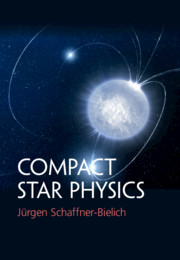9 - Hybrid Stars
Published online by Cambridge University Press: 17 August 2020
Summary
Hybrid stars are constructed by combining the neutron matter equation of state with the quark matter equation of state. Piecewise polytropes are utilized to interpolate between the limiting equations of state at low and high densities. The phase diagram of QCD is sketched and possible phase transitions are outlined. Connections to heavy-ion experiments and astrophysical systems are established. The two possible ways of constructing a phase transition, the Maxwell and the Gibbs construction, are developed. The possible existence of a pasta phase in the core is presented. The implications of a phase transition for the mass–radius relation of compact stars is discussed. The emergence of a new class of stable solutions of the Tolman–Oppenheimer–Volkoff equation, a third family besides white dwarfs and neutron stars, is put forward. The Seidov criterion for an unstable branch in the mass–radius relation is derived explicitly. Hybrid stars are classified according to the presence of the mixed phase in the mass–radius relation. The properties of hybrid stars are compared to those of ordinary neutron stars by their possible configurations in the mass–radius diagram.
Keywords
- Type
- Chapter
- Information
- Compact Star Physics , pp. 237 - 263Publisher: Cambridge University PressPrint publication year: 2020



